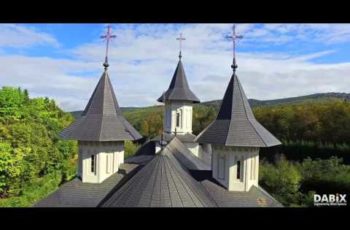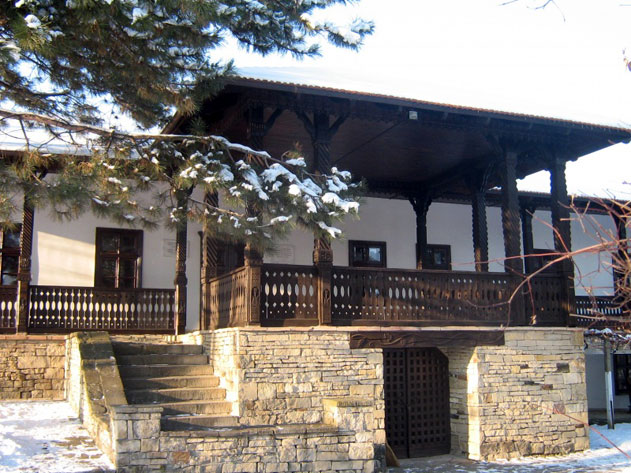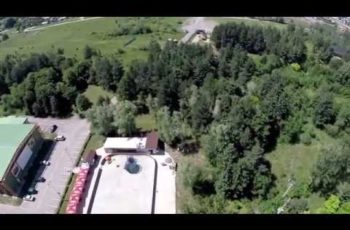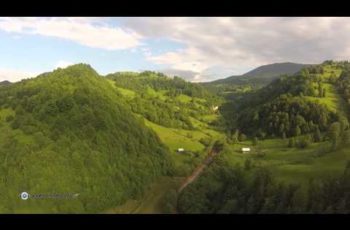Enable English subtitle ! Activați subtitrarea în românește !
Colt (corner – in Romanian) Orthodox church fortress is located at the northern foot of Retezat Mountains, above the village Suseni (village Rau de Mori, Hunedoara county). The name comes from the Colt (corner) located on the corner rock on the other side of the Rauşor Valley, both dating from the fourteenth century. Both were built by the lords Candea, famous medieval noble family of Hateg Country. Church, which is dedicated to „All Saints Sunday” currently working as hermitage with community of monks. How it looks now, monastic ensemble is the result of extensive restorations made in the last 20 years, repeating an old Orthodox hermitage who worked here in the XIV-XVI. From the seventeenth century, the settlement was abandoned, underwent decay ruin. During communist times longer keep only the tower and the nave was converted into stable. The church is distinguished by its strange looks, as one fortress, due mainly to defense tower built above the altar, to better supervise the valley. The walls having a thickness of 1.2 m are made of rough stone and are reinforced with buttresses. The church has only a rectangular short nave, and one altar with defense tower above. The entrance is directly into the nave. Valuable paintings were made sometime during 1350-1450, probably by the same Stephen craftsman who painted also Densus church. The mural painting has been compromised, only the altar keeping better, and could still recognize an ample scenes „Akathist Hymn”. In the nave of the church restoration work could save only small areas of mural painting, as seen now. the defensive church tower has 3 levels (provided with very narrow stairs, the chimney fire and pyramidal stone roof, typical for the medieval Hateg Country). The fortified Colt Church was part of the defensive system of the Colt Fortress. Colt Fortress was built several decades after construction of the church. It was no renovated, being now in an advanced state of ruin. There are many outstanding coincidences and indirect data that lead pretty sure the idea that this would be the fortress that inspired Jules Verne to write his novel „The Carpathian Castle”.
Biserica-fortăreață ortodoxă Colț este situată la poalele nordice ale Munților Retezat, mai sus de satul Suseni (comuna Râu de Mori, județul Hunedoara). Numele provine de la Cetatea Colț situată pe un colț de munte pe celălalt versant al Văii Râușor, ambele datând din secolul XIV și fiind ctitoria cnezilor Cândea, vestită familie nobiliară medievală din Țara Hațegului. Biserica, având hramul ”Duminica Tuturor Sfinților” activează în prezent ca schit cu obște de călugări. Așa cum arată acum, ansamblul monahal este rezultatul unei ample restaurări făcute în ultimii 20 de ani, reluând o veche sihăstrie ortodoxă care a activat aici în secolele XIV-XVI. Din secolul XVII, așezământul a fost abandonat, degradându-se la ruină. În perioada comunistă se mai păstra doar turnul, iar naosul a fost transformat în grajd. Biserica se remarcă prin aspectul său ciudat, de fortăreață, datorat mai ales turnului de apărare construit deasupra altarului, putând astfel supraveghea valea. Zidurile, având o grosime de 1,2 m sunt făcute din piatră brută și sunt întărite cu contraforturi. Biserica este o navă dreptunghiulară numai cu naos scurt și cu altarul-turn decroșat. Intrarea se face direct în naos. Valorosul ansamblu pictural realizat cândva în perioada 1350-1450, probabil de către același meșter Ștefan care a pictat și biserica din Densuș, a fost compromisă, doar în altar păstrând-se mai bine, putându-se totuși recunoaște scenele unui amplu ”Imn acatist”. În naos, lucrările de restaurare a bisericii au putut salva doar mici suprafețe, așa cum se vede acum. Turnul fortificat al bisericii are 3 niveluri (prevăzut cu scări foarte înguste, cu horn pentru foc și cu acoperiș piramidal din piatră, tipic pentru zona Hațeg) și făcea parte din sistemul defensiv al cetății Colț. Cetatea Colț a fost construită la câteva decenii după construcția bisericii. Nu a fost renovată, aflându-se acum într-o stare avansată de ruină. Sunt multe coincidențe deosebite și date indirecte care conduc destul de sigur la ideea că această cetate ar fi cea care l-a inspirat pe Jules Verne să scrie romanul ”Castelul din Carpați”.






JOE
Este minunat acest ,, COLT ,, de rai… Avem locuri frumoase in tara, nu toata lumea are ocazia sa vada frumusetile Romaniei… Sunteti iubitor de tara judecand dupa mortalizarea acestor cadre… cu efect … se poate ajunge la inimile oamenilor… ( pe mine m-ati convins )… …….